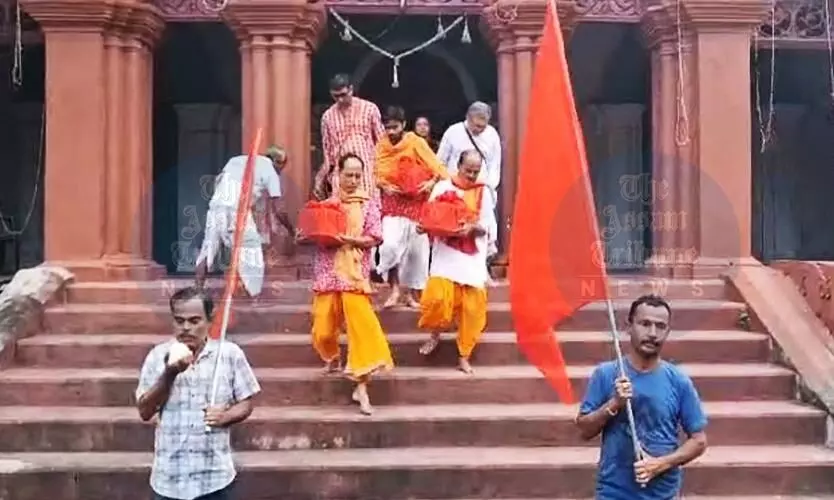404 years of tradition: Gauripur's royal Durga Puja begins with grandeur
This Durga Puja dates back to 1620. In 1850, King Pratap Chandra Barua moved the festival from Rangamati to Gauripur.

Dhubri, Oct 3: The historic town of Gauripur is abuzz with excitement as the 404-year-old Durga Puja of the Gauripur royal family began on Thursday. Held at the revered Mahamaya Temple, this centuries-old festival continues to serve as a beacon of cultural heritage and communal harmony in the region.
At precisely 7 am, devotees gathered to witness the traditional procession of the intricately crafted Goddess Durga idol, made from Shola Pith (a type of reed), along with the permanent idol made from Ashtadhatu (an alloy of eight metals). The procession moved from the Maa Mahamaya Permanent Temple to the Durga Temple at Mahamaya Ground.
Leading the procession were Rajpurohit Aruplochan Chakraborty and priest Buddha Roy, joined by Prabir Kumar Barua, president of the Gauripur Mahamaya Temple managing committee and a distinguished member of the royal family, along with devotees from across the district.
“Maintaining this age-old tradition is a matter of great pride and responsibility. It’s heartening to see the community come together, just as they have for centuries, to celebrate and uphold our rich cultural heritage,” said Prabir Kumar Barua.
The origins of this Durga Puja date back to 1620. In 1850, King Pratap Chandra Barua relocated the festival from Rangamati to Gauripur, bringing the royal family's revered deity, Kuldevi Mahamaya. While Mahamaya is worshipped year-round, the autumnal worship of Goddess Durga has become a significant event since the relocation.
One of the festival's unique aspects is the simultaneous worship of Kuldevi Mahamaya and the Durga idols made from Ashtadhatu and Shola Pith. This blend of rituals symbolises the fusion of age-old traditions with local cultural elements. Rajpurohit Aruplochan Chakraborty conducts the rituals for Kuldevi Mahamaya, while priest Buddha Roy officiates the Shardiya Durga Puja.
The festival has long been a symbol of unity and inclusiveness. Historically, the royal family extended invitations to people of all castes, creeds, and religions, distributing offerings such as straw, flattened rice (chira-muri), and curd. This practice of promoting communal harmony continues even today, reinforcing the festival’s role in bringing the community together.
Local resident Suman Das shared his enthusiasm, stating, "Participating in this festival is a cherished experience. It’s not just about religious rituals but about celebrating our shared history and bonds as a community."
The festival culminates with the immersion of the deity at the confluence of the Brahmaputra and Gadadhar rivers, symbolising the goddess’s return to her celestial abode.
